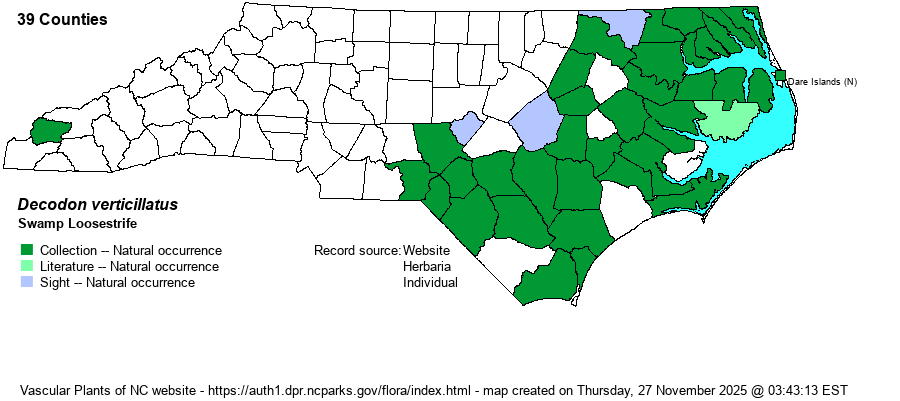| Author | (L.) Elliott | |
| Distribution | Essentially only in the Coastal Plain, where found nearly throughout the entire province. There is specimen record from a wetland in Graham County in the Mountains. As the species does occur in eastern TN, this may not be as outlandish as it seems.
Despite this being a Coastal Plain species in the Carolinas, it has a surprising range scattered across all of the eastern U.S. and southern Canada. It ranges as far south as central FL and eastern TX, and it occurs in TN, KY, WV, and other states to our west. However, it has a mysterious absence across essentially the entire Piedmont province, yet it occurs farther west in the Ridge and Valley province.
| |
| Abundance | Fairly common in the Coastal Plain, as a whole, but it can be locally abundant, as it often occurs in large stands. Even so, there are a moderate number of counties in the Coastal Plain apparently lacking records, or at least collection records. Very rare, at low elevations, in the southwestern Mountains. | |
| Habitat | This is an obligate wetland species, occurring mostly in shallow water around lake and pond/pool margins, but also in swamps, wet thickets, and other places with shallow standing water. | |
| Phenology | Blooms and fruits from July to September. | |
| Identification | This is a soft-woody, deciduous species, generally considered as a shrub but it can be considered also as an herbaceous species. It grows to about 6-9 feet tall, but it has very long and arching stems that can root at the tips. Growing in colonies, a group of these plants produce a striking scene with the abundance of gracefully arching stems. The leaves are opposite to whorled and are quite narrow, being lanceolate and growing to about 4 inches long. The flowers are quite striking, being a purple or magenta color and about 1-inch across, growing in clusters in the leaf axils. As this is the only species in the genus Decodon, it is unique in our area and should not be an identification problem, especially when in bloom. | |
| Taxonomic Comments | A few references have given varieties to the species, but most recent references do not.
| |
| Other Common Name(s) | Water-willow is another often used name. However, it is not closely related to willows (Salix), whereas Decodon is included within Lythraceae, which includes some species named as loosestrifes (in the genus Lythrum). [Note however that the genus Lysimachia, in the Family Primulaceae, also has species usually named as loosestrifes, as well.] Also note that the hyphen is preferred in the common name, even though it is often written as Swamp Loosestrife. Decodon is not truly a “loosestrife” (Lythrum or Lysimachia), which are herbaceous species. | |
| State Rank | S4 | |
| Global Rank | G5 | |
| State Status | | |
| US Status | | |
| USACE-agcp | OBL link |
| USACE-emp | OBL link |

